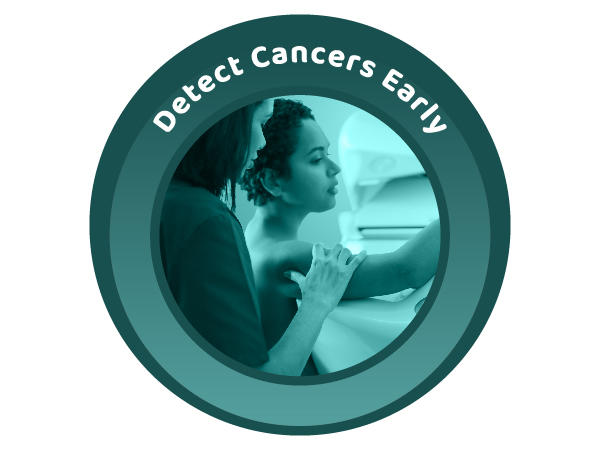Although there have been tremendous advances in treatment, far too many cancers are diagnosed late, when treatment is often less effective. Therefore, it is important that we develop more effective screening and early detection approaches to find cancer in its earliest and more treatable stages, particularly for cancers that are most deadly.
The state of early cancer detection today
At this time, only a handful of cancer screening tests are known to reduce the chance of dying of a specific cancer and to have benefits that outweigh the harms. They are:
- mammography for breast cancer
- HPV and Pap testing for cervical cancer
- colonoscopy, sigmoidoscopy, and stool-based tests for colorectal cancer
- low-dose CT scanning for lung cancer
Unfortunately, many eligible people are not getting tested, and we need to better understand why there are disparities in screening and early detection rates across different populations. There are also no proven screening tests for nearly all other cancers, which are often diagnosed based on symptoms. By then, these cancers may be more difficult to treat.
However, new technologies are under development that can detect tumor cells or DNA and other substances in blood that indicate the presence of many types of cancer before they cause symptoms. These technologies could be especially helpful in improving early detection of cancers that currently lack effective screening tests, although the research community must ensure that these advances lead to a decrease in deaths without overtreating other conditions that would have been unlikely to cause harm.
Strategies to advance early cancer detection
- Develop new methods to detect cancers, especially ones that don’t currently have effective screening tests.
- Generate new ways to detect cancer earlier through imaging.
- Find methods to identify and eliminate precancerous cells with minimal side effects.
- Conduct clinical trials to learn about the benefits and harms of new cancer detection tests.
- Partner with providers, researchers, and communities at increased risk for cancer to improve screening rates.
- Research barriers to treating early-stage cancers in communities experiencing disparities, such as financial toxicity and the need for patient navigation services.
Examples of NCI-supported research to achieve this goal
- The Tomosynthesis Mammographic Imaging Screening Trial is exploring which type of mammogram is best at screening for breast cancer in women with no symptoms.
- NCI researchers are working with colleagues across the institute and at other federal agencies to study all features of multi-cancer detection tests.
- The Early Detection Research Network (EDRN) is a consortium of more than 300 investigators at academic institutions and in the private sector working collaboratively to discover, develop and validate biomarkers and imaging methods to detect early stage cancers and to assess risk for developing cancer.
Examples of activities across the government to achieve this goal
- The Inside Knowledge About Gynecologic Cancer campaign, by the Centers for Disease Control and Prevention, addresses myths, stigma, and other barriers that prevent women from seeking cervical cancer screening, as well as care for other gynecologic cancers.
- A new National Quality Leader – Cancer Screening badge recognizes community health centers for their key role in providing potentially lifesaving access to breast, cervical, and colorectal screenings. This badge is awarded by the Health Resources and Services Administration.
- The PREMIUM study (PREventing Liver Cancer Mortality through Imaging with Ultrasound vs. MRI), led by the Department of Veterans Affairs, will help determine the most effective screening technique for liver cancer.
- The National Breast and Cervical Cancer Early Detection Program provides breast and cervical cancer screenings and diagnostic services to women who have low incomes and are uninsured or underinsured. This program is led by the Centers for Disease Control and Prevention.
- A long-standing collaboration between the National Institute of Standards and Technology and NCI’s Early Detection Research Network is helping to develop robust measurements and standards for early detection of cancer via circulating tumor DNA, methylated DNA, extracellular vesicles, and other biomarkers in liquid biopsy, like blood or urine.
